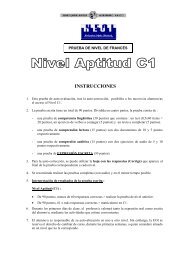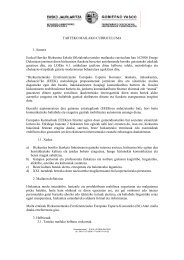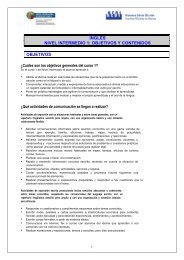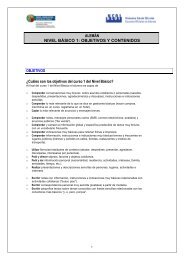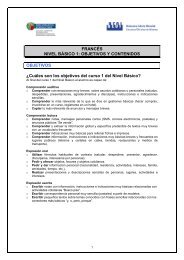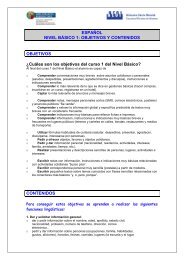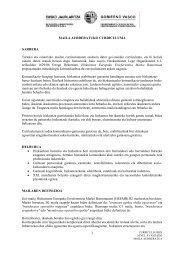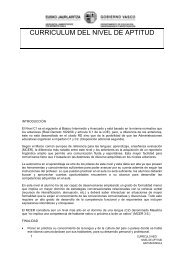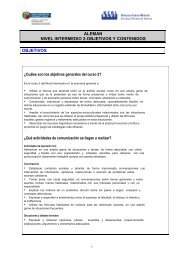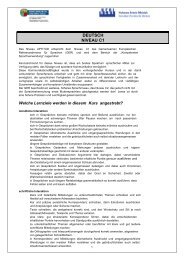C1 – Course Syllabus - Escuelas Oficiales de Idiomas del País Vasco
C1 – Course Syllabus - Escuelas Oficiales de Idiomas del País Vasco
C1 – Course Syllabus - Escuelas Oficiales de Idiomas del País Vasco
You also want an ePaper? Increase the reach of your titles
YUMPU automatically turns print PDFs into web optimized ePapers that Google loves.
common collocations, (e.g. with head words like do, make, get, end, mind, etc.).<br />
blending (merging words like breakfast with lunch = brunch; etc.).<br />
borrowings (foreign words: robot, guru, junta, haute cuisine; ... .).<br />
expressing nuance (intensifiers, downtoners, focusers, etc.).<br />
proverbs, (e.g. Too many cooks spoil the broth; ... .).<br />
phrasal idioms, (e.g. kick the bucket = to die).<br />
phrasal verbs, (e.g. set off, break down, etc.).<br />
In practice, learners should aim to …<br />
have a good command of a broad lexical repertoire allowing gaps to be readily<br />
overcome with circumlocutions; little obvious searching for expressions or<br />
avoidance strategies. Good command of idiomatic expressions and colloquialisms<br />
and <strong>de</strong>spite minor slips there are no significant vocabulary errors.<br />
5.3.4 Phonology & Orthography<br />
Phonology involves a knowledge of, and skill in the perception and production of:<br />
the phonetic composition of words (syllable structure, the sequence of phonemes,<br />
word stress, word tones)<br />
sentence phonetics (prosody)<br />
sentence stress and rhythm<br />
intonation<br />
phonetic reduction<br />
vowel reduction<br />
strong and weak forms<br />
assimilation<br />
elision<br />
In practice, learners can not only appreciate variations in intonation and sentence stress to<br />
express finer sha<strong>de</strong>s of meaning but can produce those variations to best convey their purpose.<br />
A checklist of the main practical phonological features that learners can recognise and produce<br />
at this level are to be found as follows:<br />
a) Recognition of common cases of vowel reduction, elision and strong and weak<br />
forms especially in casual or colloquial conversation. (common cases of schwa /ә /)<br />
b) Common examples of assimilation <strong>–</strong> words run together in a sentence:<br />
I_got_up_at_eight. // Don‟t_ you_like_it? // Give_me_the_money!<br />
c) Insertion of /r/, /w/, /j/ between words ending and starting with a vowel sound to<br />
facilitate pronunciation. I saw /r/ Alice // I want two /w/ eggs // In the /j / end.<br />
d) Pronunciation of auxiliary verbs in short Wh- questions in casual or colloquial<br />
conversation: What do you want? / What does he do?; Where have you been? ;<br />
Where did he go?, etc.<br />
e) Syllable lengthening, for dramatic effect and in interjections like “ehm, well” to gain<br />
time to think and hold the floor.<br />
“What did you think of the music?” “Well, :::it was interesting”<br />
”What‟s the time?” “Let‟s see, it‟s ehm::: nearly seven.”<br />
f) Rising intonation used in quotations<br />
I said, ‘Can you open the door for me?’ and he says, ‘Open it yourself’ .<br />
Also the use of Anyway / Well - in telling stories or anecdotes.<br />
g) Pronunciation of expressions with no actual meaning used in casual or colloquial<br />
conversation, (e.g., Sort of; Like; You know; I mean; Kind of; ... .)<br />
25



